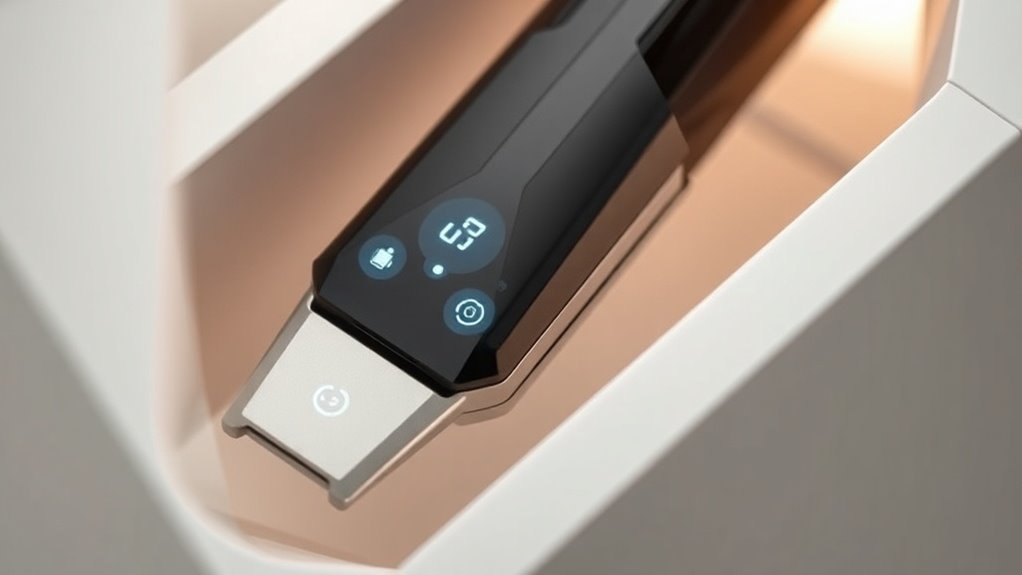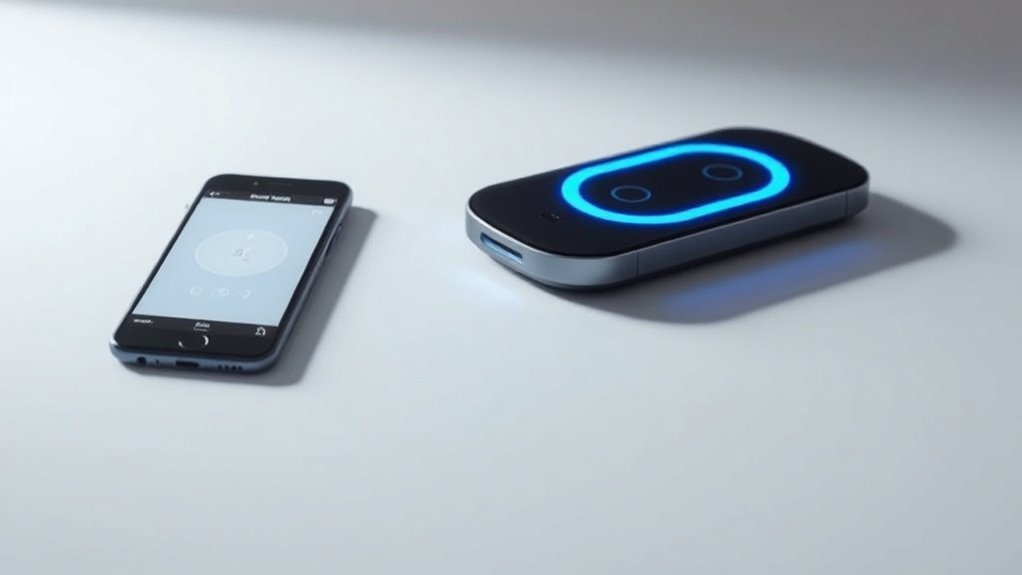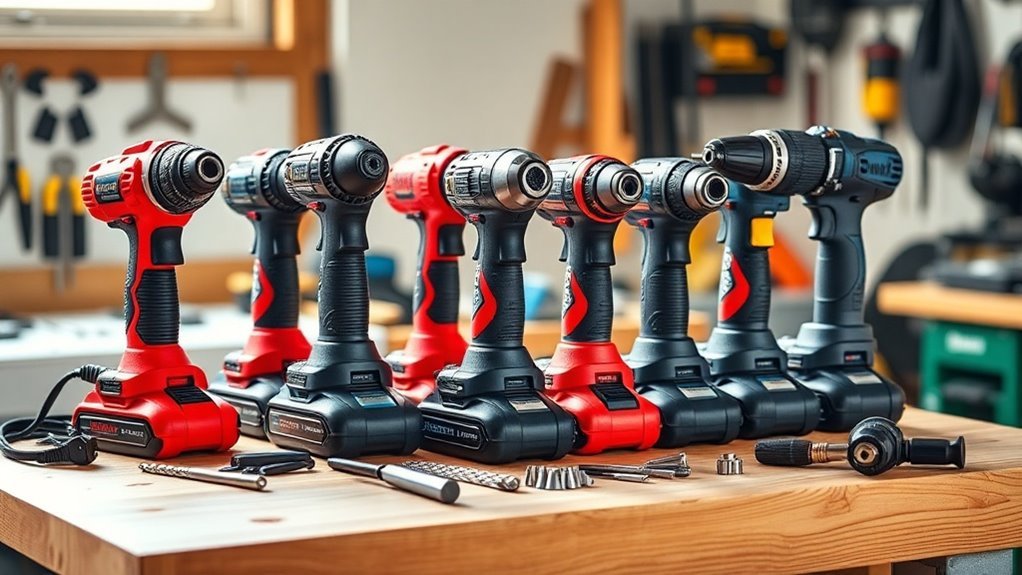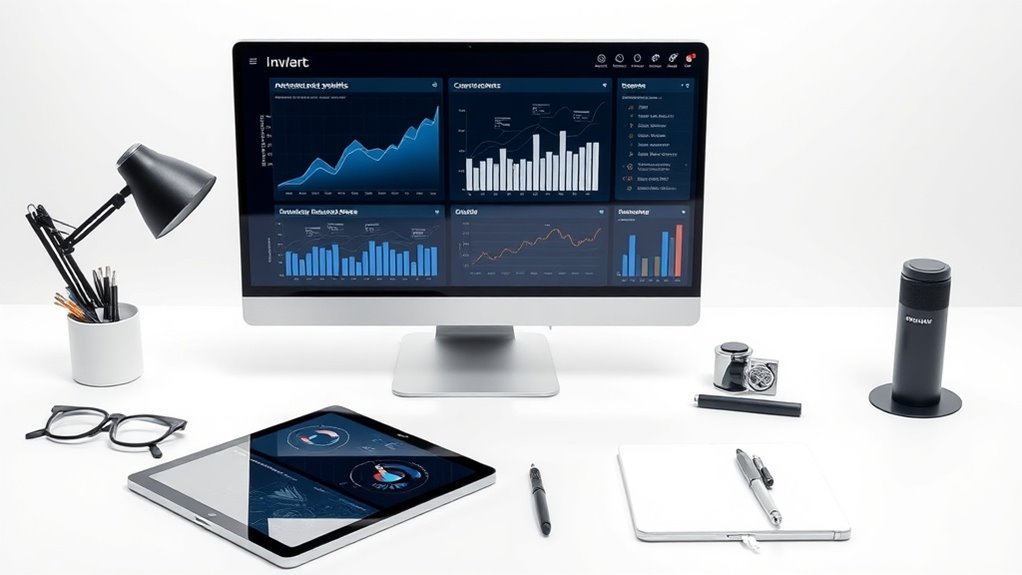Energy Efficiency in Smart Power Tools
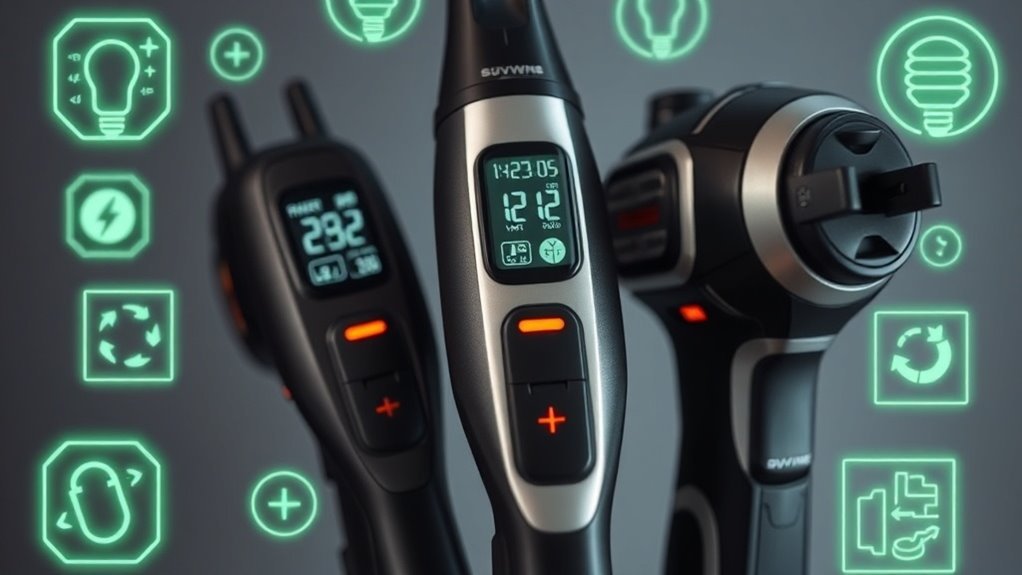
Smart power tools are designed to maximize energy efficiency, helping you save on costs while minimizing environmental impact. With features like advanced battery technology, real-time monitoring, and automatic power-down, these tools optimize performance without unnecessary energy consumption. They also adjust settings based on the material you’re working with, ensuring precision and effectiveness. By choosing smart tools, you not only enhance your productivity but also contribute to a greener future, and there’s more exciting information ahead.
Key Takeaways
- Smart power tools utilize advanced sensors and AI to optimize energy use, minimizing waste during operation.
- Enhanced battery technology in smart tools allows for longer run times and efficient charging.
- Energy-efficient tools lead to significant operational cost savings by reducing electricity consumption.
- The automatic power-down feature conserves energy when the tools are not in use.
- Environmental benefits include reduced greenhouse gas emissions and a longer lifespan for smart tools, promoting sustainability.
The Rise of Smart Technology in Power Tools
As technology evolves, you’ve likely noticed how smart features are becoming more commonplace in power tools. These innovations are designed to make your tasks easier and more efficient.
You might find tools equipped with Bluetooth connectivity, allowing you to control settings from your smartphone or receive real-time feedback on your work. Enhanced sensors can adjust performance based on material type, ensuring ideal results every time.
Additionally, digital displays give you precise readings, helping you complete tasks with greater accuracy. With tools that can even diagnose issues or suggest maintenance schedules, it’s clear that smart technology is reshaping the way you work. Furthermore, the integration of Bluetooth and app integration enhances overall productivity, making your workflow more streamlined and effective.
Benefits of Energy Efficiency in Tools
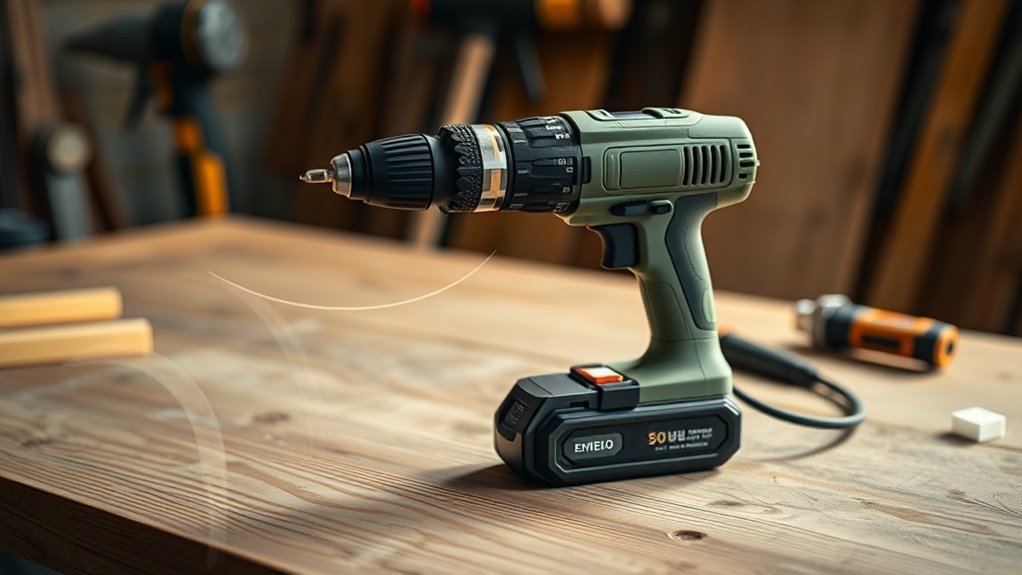
When you adopt energy-efficient tools, you’ll notice cost savings that add up over time. Not only do these tools help your wallet, but they also contribute to a healthier environment by reducing energy consumption. It’s a win-win for both your budget and the planet. Additionally, tools featuring brushless motors enhance performance while further improving energy efficiency.
Cost Savings Over Time
Achieving energy efficiency in smart power tools not only contributes to environmental sustainability but also leads to significant cost savings over time.
By investing in these tools, you’ll notice a reduction in your electricity bills due to their optimized energy use. More efficient tools require less power to do the same job, which means you’re spending less on electricity.
Additionally, many energy-efficient models come with longer lifespans, reducing the frequency and costs of replacements. With fewer repairs and replacements, you save even more in the long run.
More importantly, you can also benefit from tax incentives or rebates in some regions.
Ultimately, the savings from both reduced energy consumption and less maintenance can add up, making smart power tools a wise financial choice.
Environmental Impact Reduction
Using energy-efficient smart power tools not only boosts your productivity but also plays a pivotal role in reducing your environmental footprint. When you choose these tools, you’re decreasing your energy consumption, which ultimately leads to lower greenhouse gas emissions. This change contributes to a cleaner atmosphere and helps combat climate change.
Moreover, many energy-efficient tools are designed with sustainable materials, minimizing waste and promoting recycling.
You’ll find that such tools often have longer lifespans, reducing the need for frequent replacements and further conserving resources.
Key Features of Smart Power Tools
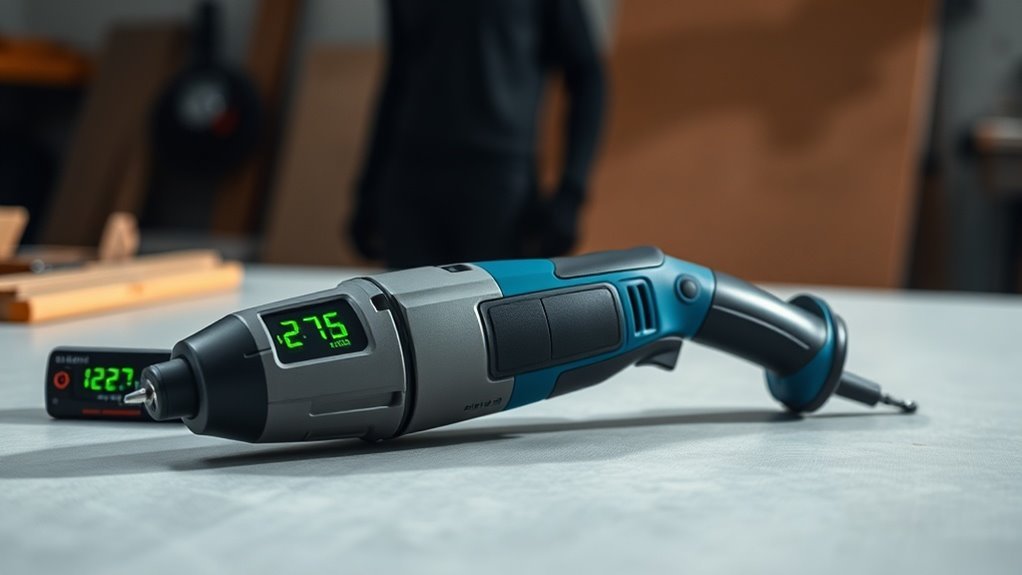
Smart power tools come packed with innovative features that make them stand out in today’s DIY and professional markets. These tools not only enhance your projects but also simplify the entire process. With smart connectivity, you can access real-time data directly from your device, ensuring precise adjustments. Additionally, many models offer variable speed controls that let you customize performance according to your needs. Lightweight designs improve maneuverability, while advanced battery technology guarantees longer use without frequent recharges. Furthermore, these tools enable enhanced user experience, making it easier for DIY enthusiasts to complete projects with confidence.
| Feature | Description |
|---|---|
| Smart Connectivity | Connects to apps for real-time data |
| Variable Speed Control | Adjustable speeds for varied tasks |
| Lightweight Design | Easy to handle and maneuver |
| Advanced Battery Tech | Longer run times and efficient charging |
| Safety Features | Automatic shut-off and overload protection |
How Smart Sensors Enhance Performance
As you explore the world of smart power tools, you’ll quickly discover how smart sensors can greatly enhance their performance. These sensors monitor various conditions, allowing the tool to adjust its settings in real-time.
For instance, if you’re drilling into a harder material, the sensor can detect increased resistance and automatically increase torque, ensuring efficient operation and reducing the risk of overheating.
Additionally, smart sensors can track battery life, so you won’t get caught off guard during a project. They can also recognize when a tool isn’t in use, automatically powering it down to save energy. This combination of responsiveness and efficiency maximizes your productivity, making your projects smoother and more enjoyable overall. Furthermore, the integration of smart tools contributes to enhanced data accuracy, ensuring that information about tool performance is reliable and actionable.
Cordless Tools and Their Energy Efficiency
While many power tools still rely on cords for operation, cordless tools have surged in popularity due to their convenience and energy efficiency.
These tools typically use lithium-ion batteries, which not only provide longer run times but also charge quickly. You’ll find that modern cordless tools are designed to minimize energy wastage, ensuring that you get the most out of every charge.
Advances in motor technology enable these tools to deliver high performance without draining the battery. Additionally, the capability of using impact drivers helps enhance efficiency, as these tools can handle tougher materials without excessive power consumption. The ability to use them anywhere eliminates the hassle of finding power outlets, allowing you to work more efficiently.
Ultimately, cordless tools are an ideal choice for both professionals and DIY enthusiasts looking to combine power, performance, and energy efficiency in their projects.
Comparative Analysis: Traditional vs. Smart Tools
When you compare traditional power tools to smart tools, you’ll notice significant differences in energy consumption.
Smart tools often utilize advanced technologies that enhance performance efficiency, saving you both power and time. Additionally, rechargeable battery technology has evolved to greatly improve the energy efficiency of these tools, further maximizing their capabilities.
Understanding these metrics can help you make more informed choices for your projects.
Energy Consumption Comparison
The energy consumption of power tools can considerably impact both performance and operational costs. When comparing traditional and smart tools, you’ll notice significant differences in efficiency.
Smart tools often integrate advanced technology that optimizes energy use, resulting in lower consumption without sacrificing power. Here are some key factors to take into account:
- Smart tools often adjust power based on task requirements.
- Traditional tools usually run at a constant power level.
- Longer battery life can mean less frequent charging with smart tools.
- Energy-efficient designs in smart tools reduce waste heat.
- Overall, smart tools can yield cost savings over time.
Performance Efficiency Metrics
As you explore the performance efficiency metrics of power tools, it becomes clear that smart tools outshine their traditional counterparts in several areas.
Smart tools often feature advanced sensors and AI capabilities that optimize energy usage during operation, minimizing waste. You’ll notice that they adjust power levels based on the task, leading to improved battery life and enhanced operational efficiency.
In contrast, traditional tools typically operate at a constant power level, which can result in unnecessary energy consumption.
Performance metrics like torque, speed, and runtime demonstrate that smart tools not only perform tasks quicker but also with greater precision. This efficiency translates to less downtime for you, making smart tools a more effective investment for both professionals and DIY enthusiasts.
Environmental Impact of Energy-Efficient Tools
Although energy-efficient tools are often viewed primarily through the lens of cost savings, their environmental impact is equally significant.
By choosing these tools, you’re not just saving on your energy bill; you’re contributing to a healthier planet.
Consider these benefits:
- Reduced greenhouse gas emissions, helping combat climate change
- Longer tool lifespan, minimizing waste and resource consumption
- Lower demand for electricity, easing stress on power grids
- Decreased air pollution from fewer emissions during manufacturing
- Enhanced recycling potential, as many energy-efficient tools use sustainable materials
Future Trends in Smart Power Tool Design
With advancements in technology shaping the industry, future trends in smart power tool design are set to revolutionize the way you work. You can expect tools that feature enhanced connectivity and smart sensors, allowing for real-time data tracking and maintenance alerts.
Integration with mobile apps will enable you to customize settings and monitor energy usage right from your phone. Plus, ergonomic designs will prioritize your comfort, making long projects less taxing.
Improvements in battery technology will lead to longer run times and shorter charging cycles, reducing downtime. Finally, you’ll find more sustainable materials being used in manufacturing, aligning with eco-friendly practices.
Together, these innovations will create a more efficient and user-friendly experience for all kinds of projects.
Questions
How Do I Choose the Right Smart Power Tool for My Needs?
To choose the right smart power tool, assess your project needs, consider the tool’s features, check compatibility with existing equipment, and read user reviews. Don’t forget to evaluate warranty and customer support options too.
Are Smart Power Tools Compatible With Traditional Accessories?
Imagine you’re using a vintage drill at a job site. You’ll find most smart power tools do work with traditional accessories, but always check compatibility beforehand to avoid any mishaps during your project.
What Is the Lifespan of a Smart Power Tool Battery?
A smart power tool battery’s lifespan typically ranges from two to five years, depending on usage and care. Regular charging habits and proper storage can help maximize the battery’s longevity and performance, ensuring you get the most out of it.
Can Smart Power Tools Connect to Smart Home Devices?
Yes, smart power tools can connect to smart home devices. This integration allows you to monitor and control their use through your smartphone, making your projects more efficient and convenient than ever before.
How Do I Maintain Energy Efficiency in My Power Tools?
To maintain energy efficiency in your power tools, keep them clean, regularly check for wear and tear, use them according to the manufacturer’s guidelines, and guarantee they’re properly charged to maximize their performance and lifespan.
Conclusion
In a world where innovation drives progress, embracing smart power tools isn’t just a choice; it’s your path to efficiency and sustainability. By opting for these advanced tools, you’re not just enhancing your performance but also contributing to a greener planet. Who wouldn’t want tools that work smarter, not harder? As technology evolves, the future of power tools looks bright—your next project could lead the way in revolutionizing energy efficiency for generations to come.


